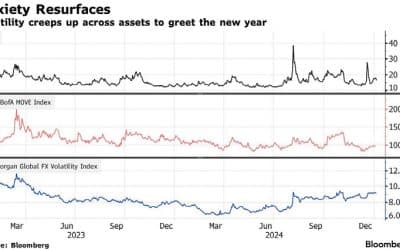EQUITY AND BOND MARKETS DROP ON US ELECTION JITTERS
Stock markets retreated in the second half of October in anticipation of the US elections. In the closing days of the month, the decline was exacerbated by earnings disappointments from some of the ‘Magnifcent Seven’.
“THE MONTHEND SELLOFF WAS SPARKED BY DISAPPOINTING OUTLOOKS FROM MICROSOFT AND META PLATFORMS”
Stocks halt winning streak S&P 500 erases its advance for October

Source: Bloomberg
The month-end sell-off was sparked by disappointing outlooks from Microsoft and Meta Platforms and concern around the significant proportion of their annual revenue being devoted to capital expenditure. Apple also fell 2% after reporting weaker-than-expected sales in China. On the final day of the month, the S&P 500 slid 1.9% and the Nasdaq a hefty 2.4%. This left both indices lower over the month.
Stepping up Capital spending as a percentage of annual revenue

Source: company data; Visible Alpha
“POSITIVE RESIDENTIAL PROPERTY SALES AND A PICK-UP IN MANUFACTURING ACTIVITY ARE LIKELY TO LIFT INVESTOR SENTIMENT – OMIT THIS ONE IF ONLY THREE ARE REQUIRED”
In the UK, the FTSE 100 fell after the autumn budget. The extent of tax increases unnerved investors and is anticipated to be a drag on economic growth in the medium to long term.
In Europe, the Euro Stoxx 50 slid 3.5% in October – its worst performance in a year. Inflation was higher than expected, dimming hopes of a 50-basis point rate cut at the European Central Bank’s December meeting. Earnings disappointed and a lacklustre economic outlook contributed to the equity market sell off.
China continued to command investor attention, with the sharp rally in onshore and offshore stock indices in late September easing off in early October and then moving sideways. For the month, the CSI 300 fell 2.3% leaving it 13.7% ahead year to date. However, further positive residential property sales and a pick-up in manufacturing activity are likely to lift investor sentiment if recent stimulus is viewed as having a significant impact.
China stocks delivered one of their strongest and most concentrated rallies ever MSCI China price (LOC, rebased)

Source: Goldman Sachs; FactSet, MSCI
“STRONG EMPLOYMENT AND ECONOMIC DATA …. TRIGGERED A SHARP SELLOFF IN US TREASURIES”
Strong employment and economic data, which could slow rate cuts, and US election uncertainty triggered a sharp sell-off in US Treasuries in October. The US 10-year Treasury yield increased to 4.28% – the highest yield in more than three months – from 3.69% at the beginning of the month.
Gold reached a record high of $2,758 an ounce in October, a 32% gain this year, before profit-taking and an easing in geopolitical risks saw some retracement in the precious metal’s price to $2,745 at month end. However, there are plenty of reasons for gold to continue rallying on the back of a secular change in the economic fundamentals underpinning the gold price. These include heightened geopolitical tensions, strong demand from China and a Fed rate cut which would reduce the opportunity cost of holding gold. The rally may also reflect ongoing efforts by global financial institutions to gradually diversify away from the US dollar as a reserve currency.
Gold slips Yellow metal coming off from recent record highs

Source: Bloomberg
“INVESTORS WERE PRIMARILY CONCERNED WITH THE £25BN INCREASE IN NATIONAL INSURANCE PAYMENTS TO WHICH EMPLOYERS WILL BE SUBJECT”
UK Markets
Shares and bonds in the UK sold off after the autumn budget was announced by the new Labour government. Investors were primarily concerned with the £25bn increase in National Insurance payments to which employers will be subject. This may result in labour market retrenchment and price increases for consumers as companies claw back their increased costs.
The higher tax bill, the prospect of additional government borrowing and a reduced chance of an interest rate cut in December saw the FTSE 100 decline 2% after the announcement.
UK gilt yields initially reacted positively but as investors absorbed the implications for government debt they shot up. An increase in US bond yields also likely contributed to the turnaround.
Government borrowing costs rise in bond sell-off

Source: LSEG
GLOBAL MARKET RETURNS OCTOBER 2024



 HELPLINE:
HELPLINE: 
